The 10 Best Mountain Bike Stems in 2020
Whether you’re replacing a worn stem or you’re making an upgrade, you have many options when considering a replacement for your old stem.
But, with so many different models on the market, it can be difficult to figure out which one is right for your bike.
Read More :
On this page, we aim to help you make the buying decision easier.
Here are our 10 favorite mountain bike stems.
Enve M7 Stem
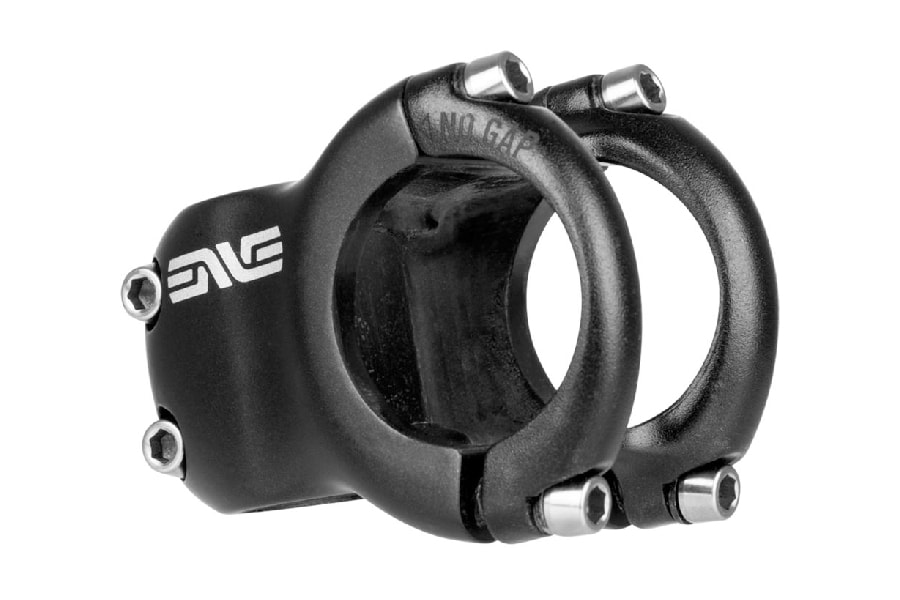
- Length : 35, 50, 65 mm
- Material : Carbon Fiber
- Clamp Diameter : 35 mm
- Rise : 0º
- Stack : 40 mm
For truly aggressive mountain bike riding, you need a stem you can feel confident will hold up when you drop into an aggressive downhill. When you’re also trying to keep weight down, that can be a difficult task. Enve’s M7 stem delivers.
It features carbon fiber construction that keeps all three sizes under 100 grams. The M7 also exudes strength, thanks to its nearly all-carbon construction right down to the threads in the stem (most carbon stems use aluminum inserts).
Couple those weight savings and strength with the 0º rise and 35 mm stack of the M7, and you have a stem worthy of trail and enduro riding.
Industry Nine A35 Stem
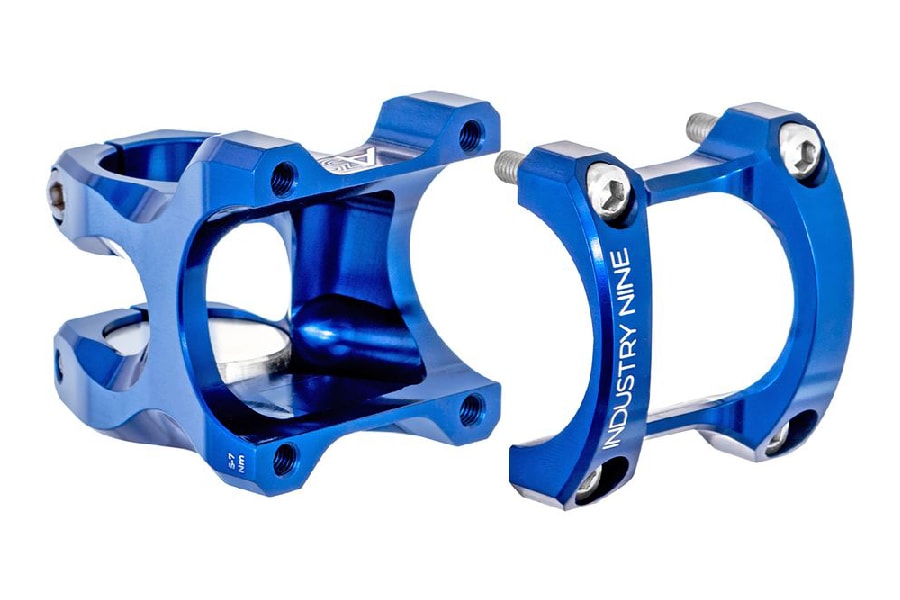
- Length : 32, 40, 50, 60 mm
- Material : Alloy
- Clamp Diameter : 35 mm
- Rise : 9º, 8º, 7º, 6º
- Stack : 40, 42 mm
If you’re familiar with Asheville, NC-based Industry Nine’s colorful wheelsets then you’ll recognize the bright colors of their A35 stem.
Although its stems may not have the same weight savings as carbon, Industry 9 uses 7075 aluminum (as opposed to the more common 6061 aluminum) and high-strength stainless steel bolts for superior strength while keeping things light.
The A35s come in 11 different colors and four different lengths. Its sizes range from 32 to 60 mm with a rise ranging from 6º to 9º, offering plenty of nice options for trail and enduro riders.
Race Face Atlas A35 Stem
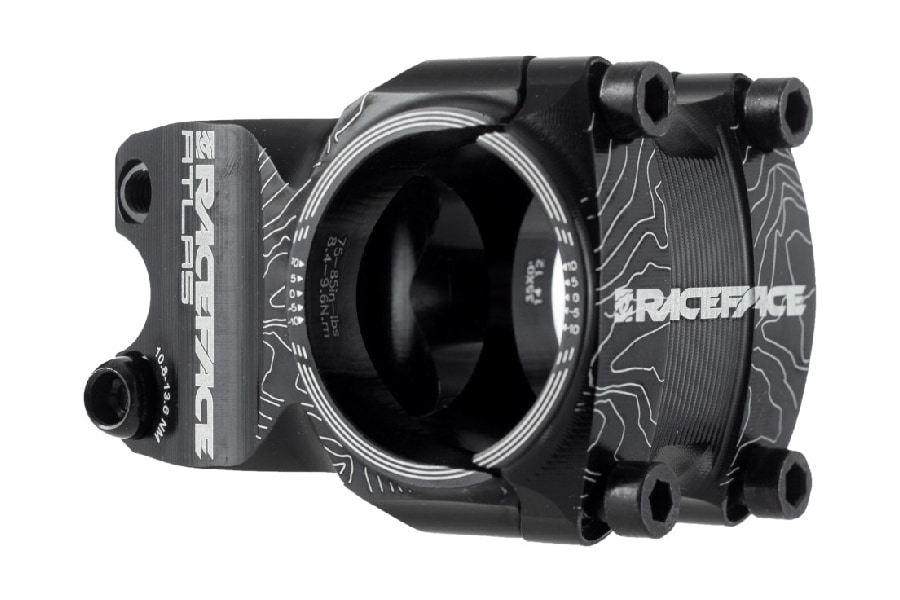
- Length : 35, 50, 65 mm
- Material : Alloy
- Clamp Diameter : 35 mm
- Rise : 0º
- Stack : 40 mm
With its 0º rise, short length, and excellent strength properties, the A35 stem is perfectly designed for downhill riding. When it comes to finding the right stem for your gravity bike, it’s about durability.
Race Face goes with 6061-T6 aluminum with this stem due to its lighter weight and higher malleability than the more brittle and heavier 7075-T6 aluminum.
Given all the stress that landing jumps and hitting terrain at high speeds put on a bike stem, this is crucial. Race Face uses four well-placed screws that evenly distribute weight on to attach the stem to the bars to thinner 35 mm diameter handlebars.
Truvative Descendant 35
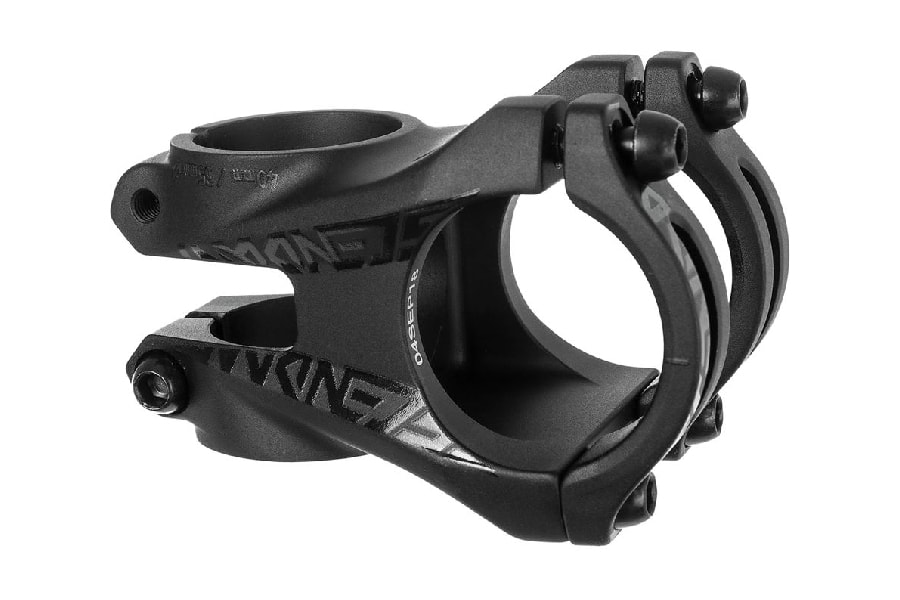
- Length : 40, 50 mm
- Material : Alloy
- Clamp Diameter : 35 mm
- Rise : 0º
- Stack : 40 mm
One of the first things you’ll notice about Truvative’s Descendant 35 stem is that it’s notably beefier than other stems. This is because Truvative uses 3D-forged 7075 alloy, giving this stem superior strength qualities.
You’ll also notice its contoured shape. Truvative maximizes strength with added thickness in the right places while machining out less crucial areas to save grams. The Descendant uses a four-bolt faceplate to evenly distribute pressure on the handlebar.
Lower-degree rise and shorter stem lengths equate to better handling. With 40 to 50 mm length and 0º rise, this stem provides the necessary responsiveness for technical trails rides and enduro racing.
Renthal Apex 35 Stem
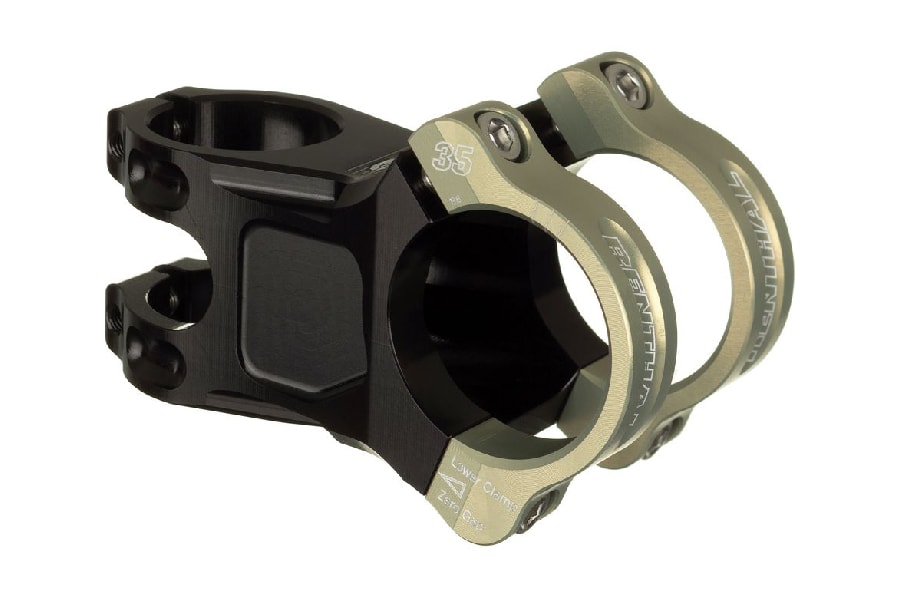
- Length : 35, 50, 65 mm
- Material : Alloy
- Clamp Diameter : 35 mm
- Rise : 6º
- Stack : 40 mm
With its Apex 35 model, Renthal, a company that specializes in handlebars for mountain bikes and motorcycles, offers a stem with a broad range of sizes to suit a broad range of riding.
With its 6ºrise, the Apex 35 hits a sweet spot that allows this stem to handle a wide range of mountain biking disciplines. Go with the 33 mm length for aggressive gravity riding or jump up to the 50 mm length for trail riding or enduro racing.
The Apex 35 is designed to fit with newer 35 mm bars. Renthal uses a wide-set four-bolt design to evenly distribute pressure, preventing damage to these thinner diameter bars.
FSA Gradient 35 Stem
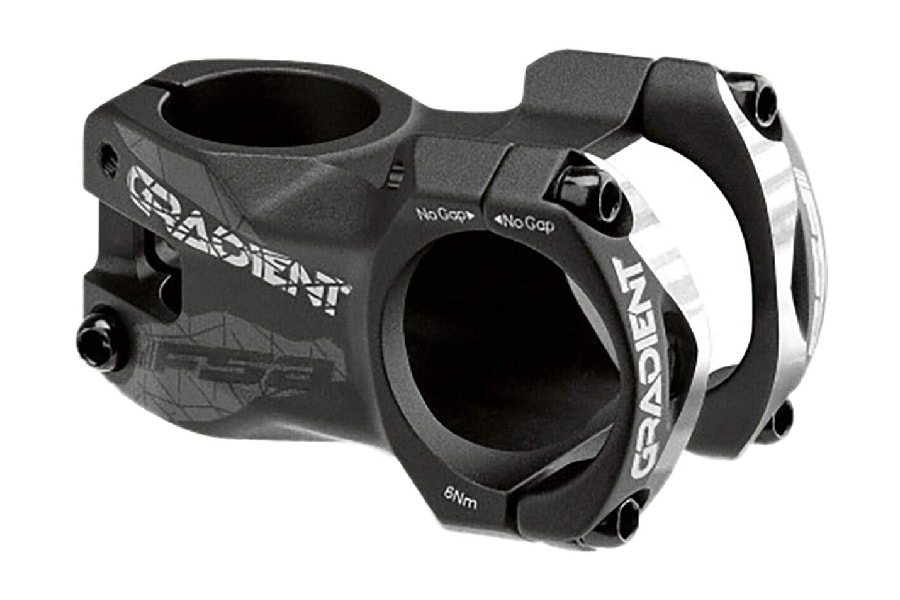
- Length : 35, 50 mm
- Material : Alloy
- Clamp Diameter : 35 mm
- Rise : 6º
- Stack : 40 mm
This 35 mm stem from components giant FSA is a durable model for newer 35mm handlebar diameters. It’s similar in design to the 45 and 60 mm gradient stem with a few notable changes.
This beefy stem is designed to handle significant pressure. And while it’s chunkier profile is a bit heavier than lighter carbon stems at 123 grams for the 35 mm, it’s also stiffer and more durable than lighter weight stems. It’s made out of 3D forged aluminum with a large 4-bolt faceplate that firmly grips the handlebars with even pressure.
It features a 6º tilt with 35 and 50 mm lengths, making it an excellent option for aggressive trail riding or enduro riding.
OneUp Components Stem
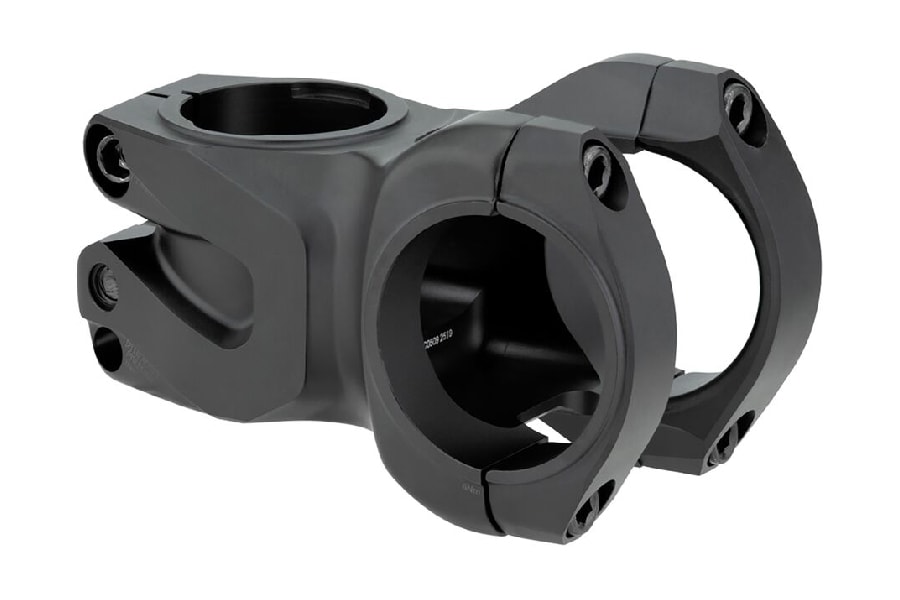
- Length : 35, 50 mm
- Material : Alloy
- Clamp Diameter : 35 mm
- Rise : 0º
- Stack : 40 mm
Finding a place to stow your tools can be a pain. They’re too heavy to have bobbing in your back pockets and can be difficult to cram into a saddlebag. The OneUp EDC Tool system stores a bike repair tool in your steerer tube, eliminating the need for a bag or pack.
This new aluminum EDC Stem allows you to use that system without having to carve threads into your fork. It also allows you to adjust your headset preload without the need to loosen the stem.
The OneUp stem comes in 35 and 50mm lengths with a 0º rise, making it a great option for downhill gravity rides or aggressive trail or enduro riding.
Chromag BZA 35 Stem
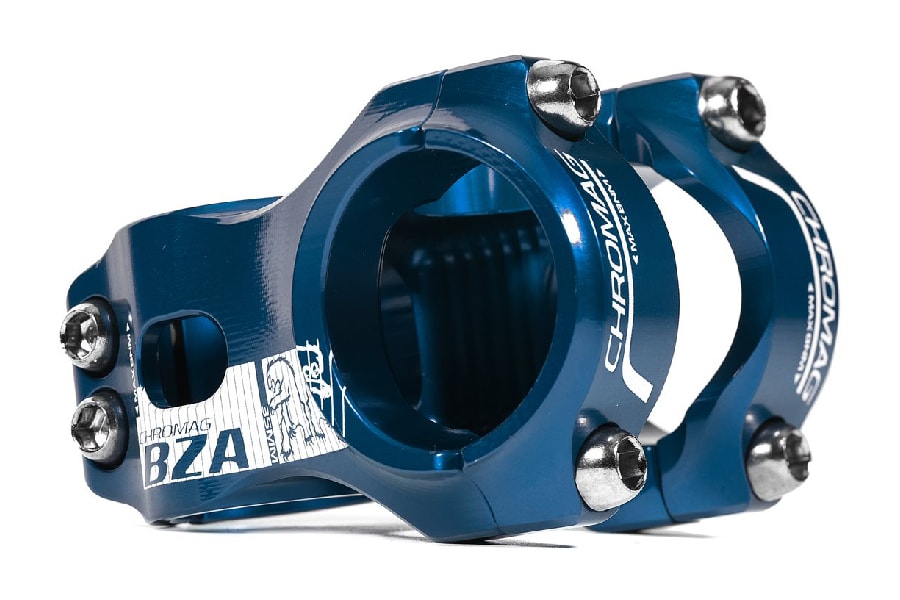
- Length : 35, 50, 60 mm
- Material : Alloy
- Clamp Diameter : 35 mm
- Rise : 0º
- Stack : 40 mm
Chromag’s take on the 35 mm stem is a little beefier than some of the 35 mm stems on the market. That much is obvious in its chunky appearance.
With its thick black aluminum alloy clamps, this stem just looks durable. Of course, that makes it one of the heavier stems you can buy at 180 grams.
Still, when we’re talking stems, which make up a pretty tiny percentage of an overall bike’s weight, the weight tradeoff is fairly negligible. This is a super stiff stem with plenty of strength and durability. The weight compromise is a small price to pay for peace of mind.
With the Chromag BZA 35 stem, you won’t be wondering whether it will hold or not midway through that 15-foot jump on the downhill track with your full-sus mountain bike.
Specialized Trail Stem
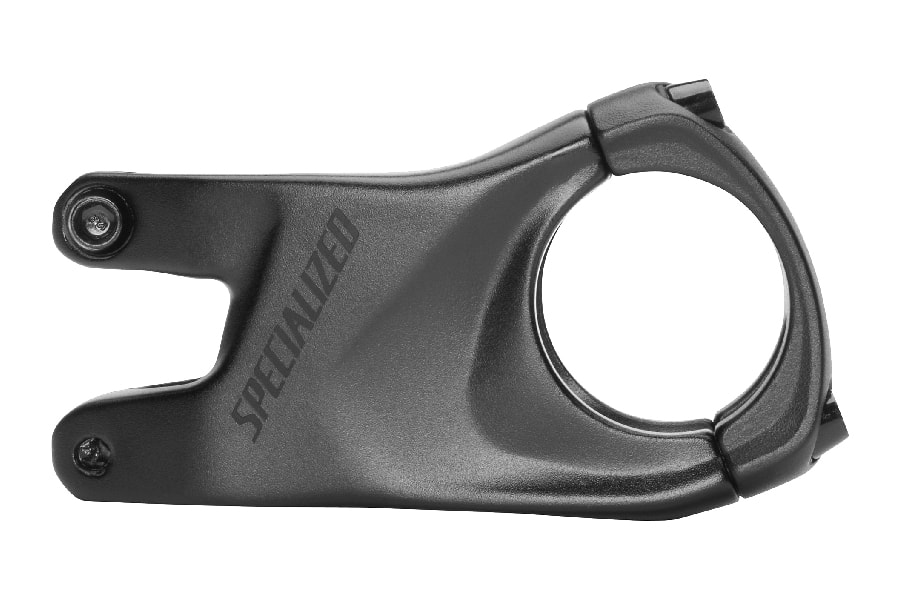
- Length : 50, 60 mm
- Material : Alloy
- Clamp Diameter : 31.8 mm
- Rise : 0º
- Stack : 40 mm
If you’re looking for an excellent stem option but haven’t upgraded to a 35 mm handlebar, check out Specialized’s Trail Stem. This very capable stem from bike manufacturing giant Specialized is an excellent option at a price that’s just a fraction of other stems.
It features a 6º rise and 40 to 60 mm length, making it a great option for trail riding or even cross-country riding. With 3D-forged alloy you can depend on this stem to offer stiff responsive steering while at the same time enduring plenty of abuse.
A 4-bolt faceplate covers enough surface area on the handlebar to distribute an even amount of force. The stem is machined with undulating curves in its body for weight savings.
Deity Components Copperhead Stem
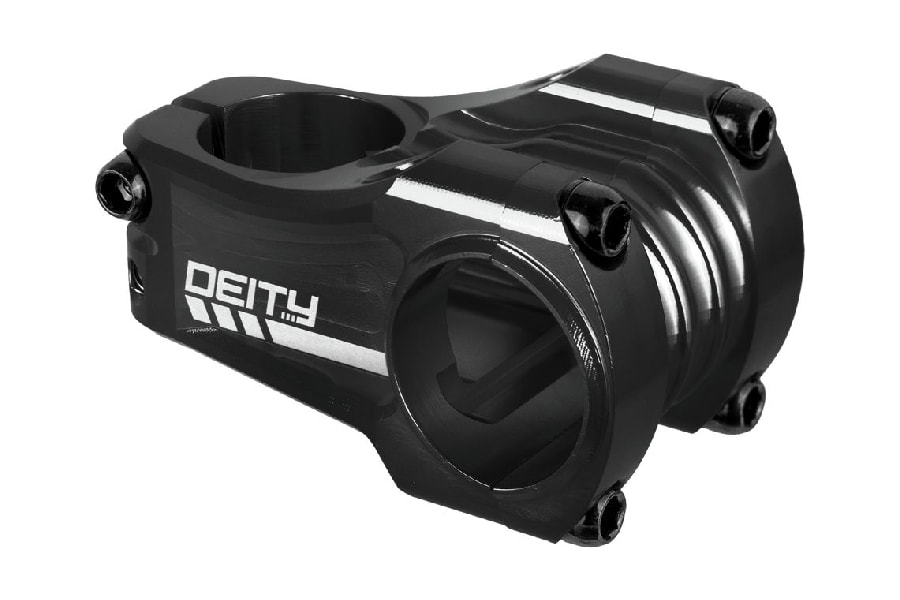
- Length : 50, 60 mm
- Material : Alloy
- Clamp Diameter : 31.8 mm
- Rise : 0º
- Stack : 35, 50, 65 mm
For those who haven’t graduated to the larger 35 mm handlebar diameter, Copperhead offers an impressive stem for 31.8 mm handlebars.
With its 35, 50, or 65 mm length, 0º rise, and extremely low 30 mm stack this stem can handle a variety of demands, from long winding trails to fast and furious gravity rides.
With it’s 6061 T6 aluminum construction it’s extremely durable and stiff without tipping the scales. It features contoured machined lines for a sleek look. Four bolts provide plenty of surface area pressure on the handlebars.
And, with its many bright color options, you’ll never overlook your handlebar stem again.
Mountain Bike Stem Buyer's Guide
With its drivetrain, wheels, frameset, and forks and rear suspension to think about, we sometimes forget about some of the smaller yet very important components on a mountain bike; the handlebar stem.
This makes little sense, given that stems play an integral role in how your bike handles.
In this section, we’ll discuss the factors you should consider when purchasing a stem for your mountain bike.
Stem Length
Length is the measure of the stem from the middle of the cap bolt on the stem to the middle of the handlebar.
Stems range in length from 30 to 80 mm.
Shorter stem length allows you to turn the handlebars more quickly, making your bike’s handling more responsive.
Stems between 30 and 50 mm such as Race Face Atlas 35 and Chromag BZA 35 are ideal for downhill riding and aggressive trail and enduro riding, which requires quick reactions on downhill technical trails.
A shorter stem shifts your riding position to the rear, putting you in a better position for descents.
Longer stems add stability and allow for more forgiving steering. They also put your weight more forward, allowing for more productive pedaling.
Longer stems in the range of 50 to 80 mm such as Enve M7 and Specialized Trail are better for cross country riding.
Steerer Tube Diameter
Steerer tube diameter refers to the diameter of the tube that runs from your handlebars through the steering tube and into the fork.
The diameter of nearly all mountain bike steering tubes is 1-1/8 inch.
If you’re not sure what’s on your bike, simply measure the diameter of the steerer tube head cap to confirm.
You’ll need to know the diameter of the steerer tube in order to purchase the right size bike stem.
Handlebar Clamp Diameter
Handlebar clamp diameter refers to the diameter of the handlebars on a mountain bike or road bike at the point where the handlebars clamp to the stem.
Most older and entry-level mountain bikes have a handlebar diameter of 25.4 mm, while newer mountain bikes use a 31.8 mm handlebar.
Many mountain bikes are now moving to an even larger standard of 35 mm, so are the stems such as Industry Nine A35 and Truvative Descendant 35.
This large diameter offers more stiffness and durability, making them a popular choice with downhill riders who appreciate the added stiffness and don’t mind the nominal weight increase.
The connection between the stem and the handlers is crucial, so it’s essential to buy a stem that is compatible with your handlebar diameter as there is no safe way to use a spacer to increase the diameter of your handlebars.
Read More : The 10 Best Mountain Bike Handlebar Grips
Stem Rise Angle
Stem rise angle measures the difference in height between the clamps of the stem.
Most stems such as those from OneUp Components, Chromag, and Race Face have a 0º rise, which means there is no change in height from one clamp to another. If you flip the clamp over, it will be the same.
A 6º rise angle means the bar will rise or fall depending on which way you install the stem.
Rise angle means little on a short 35º stem as there will be little length for any change in height to take place. A longer stem will have a much greater height change with a 6º rise angle.
A bike with a higher rise angle and length will facilitate a less aggressive more upright position on the bike.
Carbon vs Aluminum Stems
As with most any component, carbon is lighter than aluminum.
However, given that a bike stem is a relatively small component, the weight savings is almost negligible, and sometimes carbon stems weigh about the same as lightweight aluminum stems.
Carbon fiber stem does offer more stiffness and better road dampening quality; however, aluminum is more durable, which is important to consider given the forces exerted on a mountain bike stem.
And, since carbon stems such as Enve M7 are twice the cost, it’s hard to justify spending the extra money on carbon.
Stem Bolt Materials
Bolts generally come in two sizes for handlebars stems; 5 mm and 4 mm with the former offering slightly better clamping force.
As for materials, bolts come in stainless steel and titanium alloy variety.
Of the two, titanium is superior but also costs more.
Stainless steel and titanium bolts are more durable and do a better job of resisting rust and corrosion while aluminum bolts are cheaper and more likely to rust or sheer off especially if over-torqued.
The post The 10 Best Mountain Bike Stems in 2020 appeared first on The Geeky Cyclist.
